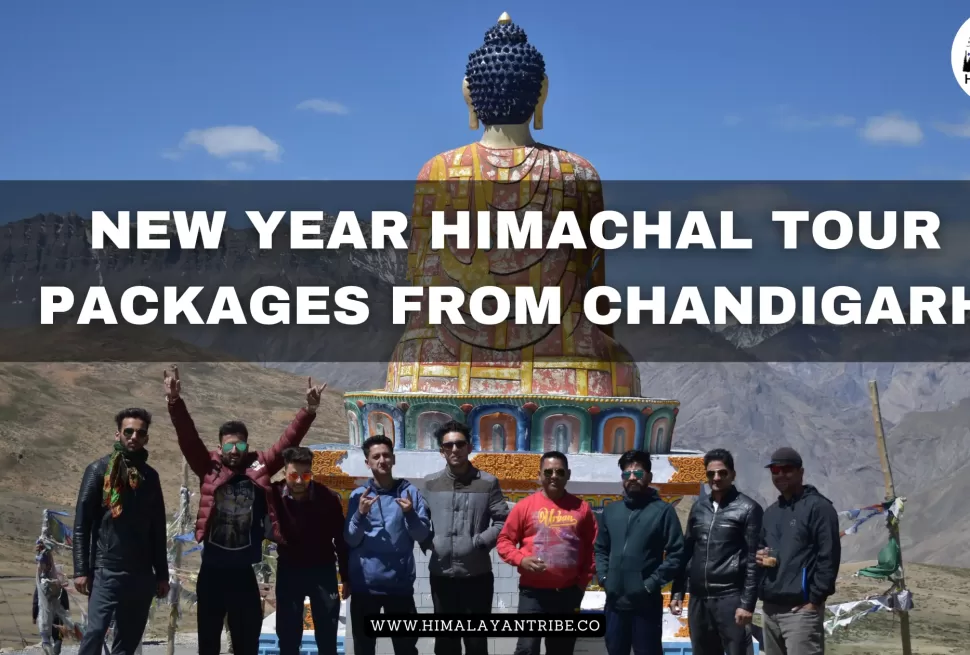Don’t be a gama in the land of Lama. Enveloped by enchanting vistas and adorned with rich historical monasteries, a Spiti Valley trip emerges as an increasingly favored destination for travelers exploring Himachal Pradesh. Often hailed as the ‘Cold Desert’ of Himachal Pradesh and the ‘Middle Land’ bridging Tibet and India, Spiti captivates adventurers and explorers with its unique allure. Poised at an impressive altitude of 14,010 ft, Spiti Valley provides a sanctuary for elusive snow leopards, majestic ibex, and cunning foxes.
Embark on your Spiti Valley trip, and traverse from the mesmerizing Moon Lake, known as Chandertal, to the remarkable Chicham Bridge – Asia’s tallest hanging bridge – as Spiti Valley unfurls a tapestry of breathtaking locales before you. Amidst this awe-inspiring backdrop, relish in the indulgence of delectable local cuisines and bask in the warmth of the hospitable locals. Immerse yourself in the embrace of Tibetan culture, a pervasive presence that graces every nook and cranny of Spiti Valley.
Whether you’re embarking on a family escapade, traveling with friends, or seeking an intimate getaway as a couple, your Spiti Valley trip promises an unparalleled vacation opportunity. It beckons you with an array of splendid sightseeing options and presents moments of leisure that effortlessly rejuvenate the soul.”
For a Comprehensive Selection of Spiti Valley Trip Packages and Itineraries, Click the Link Below
https://himalayantribe.co/destinations/book-spiti-tour-packages/
Ideal Time to Begin Your Unforgettable Spiti Valley Trip
Instagram reels and social media posts have created an illusion of Spiti Valley trip as a magical desert oasis, complete with rivers and snow. However wondrous Spiti Valley may appear on these platforms, the reality is that without proper planning for your Spiti Valley trip circuit or tour, the cold desert can pose significant survival challenges.
From extreme cold that chills to the bone to sunburn that scorches the skin, Spiti Valley offers breathtaking views in every weather condition.
The peak tourist season for a Spiti Valley trip is from May to the end of June, as well as late December. During this time, accommodations such as hotels and homestays, as well as transportation like cabs in Spiti Valley, become quite expensive due to high demand.
Embracing the Summers During your Spiti Valley trip
During the summer months, from mid-May to July, Spiti experiences a moderate temperature range of 10°C to 20°C. This season is widely regarded as the optimal time for a Spiti Valley trip, as the weather strikes a harmonious balance between warmth and coolness. With the sun setting around 7 to 8 pm, you’re granted ample time to delve into village exploration and nearby escapades.
The summer months mark the peak tourist season in Spiti, thanks to the favorable road conditions from Manali that enable a complete Spiti circuit to be undertaken. However, it’s important to note that accommodations such as hotels, homestays, and cab services in Spiti can be notably more expensive during this vibrant period of the year.
Winters of Spiti: A Mesmerizing Spiti Valley Trip Amidst the Snowy Serenity
The winter season graces Spiti Valley trip from late October, casting its enchantment until April. During these months, the temperature gracefully glides between 10°C and -20°C, painting the landscape in an ethereal wintry hue. While the road connectivity from Manali to Spiti hibernates during this season, a passage to Spiti Valley remains open via Shimla.
The delicate ballet of snowfall commences its enchanting dance in late November, crescendoing into a symphony of heavy snowfall from late December through March. For those yearning to experience a winter Spiti Valley trip, particularly a snow road trip or an expedition, the ideal window is between January and February. The allure of Spiti’s Christmas and New Year celebrations is heightened by the possibility of witnessing snowfall, extending its gracious invitation to enhance the festive atmosphere.
Even as roads may temporarily yield to the weight of snowfall, local authorities diligently restore access, ensuring a seamless exploration opportunity for tourists. Adventurers equipped with a 4×4 vehicle are in for a treat, as winter bestows the perfect opportunity for exhilarating snow rides within the encompassing Spiti area. Without a doubt, Spiti stands as a premier winter destination, beckoning travelers to partake in invigorating 4×4 rides through the captivating snow-laden terrain.
Spiti Valley Trip During Monsoon
Among the various regions in Himachal Pradesh, a Spiti Valley trip unveils a unique facet—receiving the scantest rainfall during the monsoon season.
Travelers embarking on a Spiti Valley trip are advised to exercise caution during this period, given the mountainous terrain’s susceptibility to landslides. As the monsoon graces the region, the Pin Valley National Park springs to life, embellished with luxuriant greenery that strikingly contrasts the backdrop of desert-like mountains enveloping it.
Epic Spiti Valley Road Trip: Your Guide on How to Reach Spiti
Spiti Valley is exclusively accessible via road, offering a unique road trip experience. Nevertheless, there are nearby railway stations and airports that serve as starting points for your journey. Tourists can choose to commence their unforgettable Spiti Valley road trip from either Manali or Shimla during the summer and monsoon seasons.
However, during the winter months, access to Spiti is restricted solely to the Shimla side, adding an element of seasonal intrigue to your adventure.”
Spiti Valley Trip Via Air
To kick-start your remarkable Spiti Valley trip, you’ll find the nearest domestic airport in Bhuntar – the Kullu-Spiti Airport (KUU) – situated just 231 km away from Spiti. Upon arrival, arranging a cab for your Spiti Valley trip is seamless. While regular flights link this airport to Delhi and Chandigarh, it’s important to bear in mind that airfares can lean towards the relatively expensive side.
For travelers in search of more budget-conscious flight choices, the Shaheed Bhagat Singh International Airport (IXC) in Chandigarh stands as the nearest international airport to Spiti, located at a distance of 488 km. As you touch down here, the option to conveniently book a cab for your Spiti Valley tour awaits you.
Be it the convenience of the Kullu-Spiti Airport or the cost-effective avenue of the Chandigarh alternative, your journey into Spiti guarantees a blend of anticipation and exhilaration.
Spiti Valley Trip Via Road
Embarking on a Spiti Valley trip via road opens up two distinct paths, each with its own allure and challenges.
The first route, accessible exclusively during the summer months, begins from the Manali side. This picturesque journey spans around 8-9 hours, guiding you through the captivating Kaza Grampho road. However, exercising caution is paramount, given the 15 hairpin turns that adorn this route and the off-road terrain it encompasses.
The second option leads you to Spiti through Shimla, tracing the Hindustan Tibet Road. This extended route grants tourists the opportunity to immerse themselves in the splendor of Kalpa, Chitkul, and Sangla villages nestled within the Kinnaur district. Anticipate a two-day expedition from Shimla to Spiti, adorned with breathtaking vistas and charming detours.
As the monsoon season sets in, both the Hindustan Tibet Road and the Kaza Grampho road may encounter landslides at certain vulnerable points. Rest assured, the authorities work diligently to promptly clear these obstacles. As winter casts its icy embrace, remain vigilant amidst fog and black ice. Prior to embarking on your journey into the captivating Himachal region, ensure that your vehicle’s hazard lights are in optimal working condition.
Must-Visit Destinations on Your Spiti Valley Trip
From the Iconic Key Monastery to the Highest Post Office in Hikkim, and the Enchanting Fossil Village of Langa to the Magnificent Moon Lake, Chandertal Lake, Spiti Valley Trip Offers a Wealth of Captivating Destinations to Explore
CHANDERTAAL LAKE
At an impressive altitude of 14,200 ft, Chandertaal Lake, also known as the Moon Lake, stands as one of the most exquisite bodies of water in Himachal Pradesh. Encircled by the majestic CB mountain ranges, its turquoise blue waters create a breathtaking vista. The lake itself mirrors the shape of a crescent moon. Adding to its allure, an episode from the Epic Mahabharat recounts how God Indra escorted the eldest Pandava, Yudhishthira, to heaven from this very location, infusing the lake with spiritual significance. Notably, taking a bath in Chandertaal Lake is prohibited.
The road leading to Chandertaal is only accessible during the summer months, specifically from May, and is closed off during the winter season, typically after the conclusion of October.
KEY MONASTERY
Nestled just 15 km from the subdivisional headquarters of Spiti, Kaza, the Key Monastery stands as a magnificent testament to Spiti’s spiritual heritage. As the largest training center in the region, it nurtures and imparts wisdom to around 300 lamas. The Key Gompa’s astonishing monastic architecture spans three impressive floors, each holding a treasure trove of history and art.
The monastery’s walls come alive with intricate murals that vividly depict the essence of Buddhism. Amidst its hallowed halls, a precious collection of ancient books, revered murals, and paintings of Lord Buddha adorn the sacred space, immersing visitors in a profound journey through time and spirituality.
KAZA
Nestled alongside the tranquil Spiti River, Kaza sits at an elevation of 11,980 ft, casting a spell of remoteness that is only matched by its significance as the subdivisional headquarters of Lahaul and Spiti. Within Kaza’s charming embrace, travelers are welcomed to discover an array of accommodations, ranging from cozy homestays to inviting resorts. Numerous local cuisine restaurants grace the town, inviting visitors to savor the flavors of the region.
Serving as a common haven for all tourists venturing into Spiti, Kaza offers a convenient and central base from which to embark on explorations of nearby villages and monasteries, all without the worry of accommodation and sustenance. A visit to Kaza ensures an authentic Spiti Valley experience, where the allure of nature’s beauty is effortlessly intertwined with the comforts of a welcoming town
HIKKIM
Perched at an impressive elevation of 14,400 ft, Hikkim proudly claims the title of being one of the world’s highest post offices. This exceptional establishment allows tourists to send postcards to their loved ones or even back to themselves, marking their presence in this extraordinary location. The village also boasts a charming restaurant where visitors can indulge in local cuisines and delectable Tibetan dishes, adding a flavorful dimension to their exploration.
Situated just 15 km away from Kaza town, Hikkim beckons adventurers to its heights, offering a one-of-a-kind experience that combines stunning landscapes, cultural encounters, and the joy of sending heartfelt messages from the top of the world.
LANGZA
Nestled at the foot of the majestic Chau Chau Kang Nilda Mountain, Langza stands as Spiti’s captivating fossil village. Eons ago, Langza lay submerged beneath the Tethys Ocean, more than 200 million years in the past. Today, visitors have the unique opportunity to unearth fossils of ancient marine life that once thrived in these ancient waters, creating a tangible link to the prehistoric past.
Adding to the village’s allure is a timeless sentinel – a serene, thousand-year-old golden Buddha statue that stands as a guardian over Langza’s tranquility. Situated just 16 km from Kaza and sharing the road with Hikkim village, Langza beckons travelers to explore its geological wonders, cultural treasures, and the whispers of an age long gone
CHICHAM BRIDGE
Standing as the world’s highest bridge above sea level, the Chicham Bridge is a remarkable feat of engineering, perched at an impressive altitude of 13,250 ft. This architectural wonder serves as the vital link connecting the Chicham and Kibber villages within the captivating expanse of Spiti Valley. Gazing down from this vantage point, travelers are left utterly mesmerized by the sheer depth of the gorge below, plunging a staggering 1000 ft.
Located a mere 19 km from Kaza town, the Chicham Bridge promises an awe-inspiring journey, both in its breathtaking views and the striking achievement it represents in the realm of infrastructure.
KIBBER WILDLIFE SANCTURY
Nestled at a lofty altitude of 14,100 ft, the Kibber Wildlife Sanctuary stands as a sanctuary for nature’s wonders. Home to a diverse array of wildlife, including approximately 30 elusive snow leopards, nimble red foxes, and the majestic ibex, often referred to as mountain goats, this sanctuary encapsulates the breathtaking biodiversity of the Himalayan region.
Kibber village, located a mere 19 km from Kaza, serves as the gateway to this remarkable sanctuary. It emerges as a hotspot within Spiti Valley, particularly renowned for offering unparalleled opportunities to spot snow leopards during the winter months. The village now boasts a range of accommodations that cater to wildlife enthusiasts, making it an inviting haven for those eager to immerse themselves in the splendor of the Himalayan wilderness.
KUNZUM PASS
Standing at a majestic altitude of 14,931 ft, Kunzum Pass, also known as Kunzum La, presents an awe-inspiring panorama adorned with glaciers and the ethereal embrace of snow-cloaked peaks. This pass serves as more than just a connection between Spiti and Lahaul valleys; it’s a gateway to nature’s grandeur.
Spanning a distance of 122 km from Manali, Kunzum La offers a breathtaking journey complete with 15 hairpin bends, rugged off-road stretches, and even river crossings. For those embarking from Kaza, the pass beckons from a distance of 79 km.
Perched atop this pinnacle is the spiritual haven of Kunzum Mata Mandir, which holds profound significance for the valley’s inhabitants. As the pass opens its doors from the end of April to November’s close, travelers are granted a limited window to experience its majestic allure and the boundless beauty it unveils.
PIN VALLEY NATIONAL PARK
Encompassing an expansive area of 675 sq. km, Pin Valley National Park stands as a distinguished gem among India’s national parks. Nestled within the embrace of Spiti Valley, this protected haven boasts a unique charm and biodiversity. The park’s high altitude and the formidable embrace of extreme temperatures have sculpted an environment where vegetation finds a delicate balance. While the landscape may appear sparse, it conceals a treasure trove of biodiversity, with the discovery of twenty-two rare and endangered medicinal plant species adding to its allure.
Positioned 50 km from Kaza, the park beckons nature enthusiasts to embark on a journey of discovery. En route to the park, travelers are treated to mesmerizing waterfalls that cascade in stunning display. The village of Mudh also graces the path, offering a warm welcome with accommodations and delectable cuisine for weary adventurers. Within this pristine expanse, Pin Valley National Park offers an experience that seamlessly blends exploration, conservation, and the sheer awe of nature’s splendor.
TABO MONASTERY
Established in the year 996 CE, Tabo Monastery stands as a testament to enduring spiritual devotion, recognized as the oldest continuously operating Buddhist enclave in both India and the Himalayas. Within its hallowed halls, a treasure trove of well-preserved manuscripts, intricate statues, and captivating paintings await. The monastery’s architectural grace is highlighted by its nine resplendent temples, four ornate stupas, and serene cave shrines, each whispering stories of centuries past.
Immersing oneself within the main temple’s ambiance, paintings that have graced its walls for centuries offer a glimpse into the artistic brilliance of the 10th to 11th centuries. For travelers embarking on the journey from Shimla to Spiti, Tabo serves as a haven, offering a night’s respite and an opportunity to connect with the spirituality and history that grace this sacred site
DHANKAR MONASTERY
Rooted in linguistic symbolism, “Dhang” or “Dang,” meaning cliff, harmoniously intertwines with “Kar” or “Khar,” signifying fort, giving rise to Dhankar Monastery. Perched dramatically on a 1000 ft high spur, this spiritual bastion graces the elevated terrain of Dhankar village, resting at an impressive altitude of 12,800 ft. Its location is a testament to its title, as it holds a place among the world’s most awe-inspiring gompas.
From its lofty vantage point, the monastery unveils a breathtaking panorama: the confluence of the Spiti and Pin rivers, a sight that never fails to captivate. Emanating from antiquity, Dhankar Monastery’s origins trace back to a fort, a stronghold hailing from the 17th century when Dhankar reigned as the capital of the Spiti Valley kingdom. Positioned 31 km from Tabo village, Dhankar Monastery stands as a tribute to both spiritual devotion and historical legacy.
How To Plan A Spiti Valley Trip
Traversing the captivating landscapes of Spiti Valley offers two distinct pathways, each with its own allure and challenges – the journey from Manali and the route from Shimla. The former takes a day via the Grampho-Kaza road, leading adventurers through mesmerizing terrains to Spiti. However, it’s important to note that these roads close during the winter months, enveloping Spiti in a seasonal slumber.
Conversely, the Shimla route extends over two days, weaving its way through the Hindustan Tibet Road, ensuring that the magic of Spiti remains accessible even during winter’s embrace.




